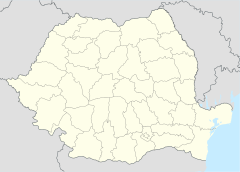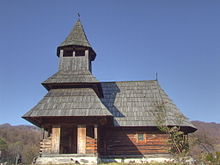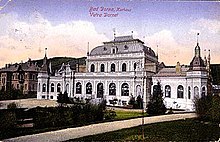Călimani National Park
| Călimani National Park | ||
|---|---|---|
| Călimani National Park | ||
|
|
||
| Location: | Romania | |
| Next city: | Vatra Dornei | |
| Surface: | 24,041 km² | |
| Founding: | 2000 | |
| Călimani National Park | ||
The National Park Calimani (Romanian: Parcul Naţional Călimani ) is a protected area of IUCN category II in Calimani Mountains , in the Eastern Carpathians , in northern Romania . It extends over the districts of Mureș , Suceava , Harghita and Bistrița-Năsăud .
description
The Călimani National Park has a surface of 24,041 hectares. It almost completely includes the Călimani Mountains, of volcanic origin. The volcanic crater is the largest in Romania with a diameter of 10 kilometers. The sights of the national park include bizarre rock formations such as "The Red Stones" ("Pietrele Roșii") or "The 12 Apostles" ("12 Apostoli").
flora
The flora is very diverse and a special attraction for visitors. Here we find numerous rare plant species such as the Allermann's armor ( Allium victorialis ), the narcissus-flowered anemone ( Anemone narcissifolia ) or the dwarf primrose ( Primula minima ). Endemic plants of the national park are: Centaurea phrygia , Dyanthus tenuifolius and Hepatica transsilvanica .
- Conifers
The following conifers can be found in the Călimani National Park:
White fir ( Abies alba ), European larch ( Larix decidua ), Swiss stone pine ( Pinus cembra ), European yew ( Taxus baccata ), Scots pine ( Pinus sylvestris ), mountain pine ( Pinus mugo ), Alpine juniper ( Juniperus sibirica ) Common juniper ( Juniperus communis )
- Deciduous trees
The deciduous trees of the national park include:
Common beech ( Fagus sylvatica ), sessile oak ( Quercus petraea ), English oak ( Quercus robur ), hornbeam ( Carpinus betulus ), sycamore maple ( Acer pseudoplatanus ), Norway maple ( Acer platanoides ), winter linden ( Tilia cordata ), common ash ( Fraxinus excelsior ) , maple ( Acer campestre ), birch ( Betula pendula ), elm ( Ulmus glabra ), maple ( Acer platanoides ), two-color willow ( Salix bicolor ), lavender willow ( Salix eleagnos ), green alder ( Alnus viridis ) , Black alder ( Alnus glutinosa ).
- Bushes
The shrubs are represented by the following species:
Siebenbürgische Alpenrose ( Rhododendron kotschyi ), Cornus ( Cornus mas ), European hazel ( Corylus avellana ), Crataegus monogyna ( Crataegus monogyna ), blueberry ( Vaccinum myrtillus ), black elder ( Sambucus nigra ), blackberry ( Rubus fruticosus ), Raspberry ( Rubus idaeus ), Dog rose ( Rosa canina ), lingonberry ( Vaccinium vitis-idaea ).
- Herbaceous plants
The herbaceous plants of the national park include:
Angelica ( Angelica archangelica ), Viola dacica , Langblättriges Hasenohr ( Bupleurum longifolium ) cephalanthera longifolia ( Cephalanthera longifolia ) Brown Red Stendelwurz ( Epipactis atrorubens ) Broad Stendelwurz ( Epipactis helleborine ), pits gentian ( Gentiana punctata ), Real meadowsweet ( Filipendula ulmaria ), forest cranesbill ( Geranium sylvaticum ), globe flower ( Trollius europaeus ), Fragrant Händelwurz ( Gymnadenia odoratissima ) twayblade ( Listera ovata ), Small two-sheet ( Listera cordata ) bleaching wood-rush ( Luzula pallescens ) Melampyrum saxuosum , calamine Spring chickweed ( Minuartia verna ), fire-orchid ( orchis ustulata ) High lousewort ( Pedicularis exaltata ), devil's claw ( Phyteuma tetramerum , Phyteuma vagneri ), two-bladed Waldhyazinthe ( Plata bifolia ), Austrian ribs Same ( Pleurospermum austriacum ) Spring fingers cabbage ( Potentilla tabernaemontani ), Carpathian buttercup ( Ranunculus c arpaticus ), Red salsify ( Scorzonera purpurea ), water groundsel ( Senecio aquaticus ssp. barbareifolius), River ragwort ( Senecio fluviatilis ), Forest Soldanelle ( Soldanella montana ), Thymus comosus , Austrian thyme ( Thymus glabrescens ), Rosa Kugelorchis ( Traunsteinera globosa ) and the endemics Phrygian knapweed ( Centaurea phrygia ), Dianthus tenuifolius , Hepatica transsilvanica .
fauna
The wildlife of the national park is very diverse, represented by mammals and birds, some of which are on the IUCN Red List.
- Mammals
The mammals in the national park include:
Brown bear ( Ursus arctos ), red deer ( Cervus elaphus ), roe deer ( Capreolus capreolus ), wolf ( Canis lupus ), wild boar ( Sus scrofa ), red fox ( Vulpes vulpes crucigera ), Eurasian lynx ( Lynx lynx ), otter ( Lutra lutra ), Squirrel ( Sciurus carolinensis ), pine marten ( Martes martes ), European polecat ( Mustela putorius ), European mole ( Talpa europaea ), Alpine shrew ( Sorex alpinus ), wood shrew ( Sorex araneus ), field vole ( Microtus arvalis ), bats .
- Birds
The following bird species can be found in the national park:
Golden Eagle ( Aquila chrysaetos ), Sperber ( Accipiter nisus ) Schwanzmeise ( aegithalos caudatus ), grouse ( Tetrao urogallus ), Habicht ( Accipiter gentilis ), Schreiadler ( Aquila pomarina ), Raven ( Corvus Corax ), dipper ( Cinclus cinclus ), Schafstelze ( motacilla flava ), Gimpel ( Pyrrhula pyrrhula ), wagtail ( motacilla cinerea ), Dreizehenspecht ( Pycoides tridactylus ), Siskin ( Carduelis spinus ) tit ( Parus ater ), Fichtenkreuzschnabel ( Loxia curvirostra ), Stieglitz ( Carduelis carduelis ) Haubenmeise ( Parus cristatus ), Peregrine falcon ( Falco peregrinus ), golden cockerel ( Regulus regulus ), song thrush ( Turdus philomelos ), woodcock ( Scolopax rusticola ).
Touristic attractions
In the vicinity of the national park there are numerous historical, cultural and tourist attractions:
- the wooden church "Sfântul Nicolae" by Răstolița (18th century)
- the wooden church "Sfântul Dumitru" by Poiana Stampei (19th century)
- the wooden church of Bilbor (1795–1797)
- the monastery of Toplița , founded in 1924 by the Patriarch Miron Cristea
- the church "Nașterea Maicii Domnului" from Vatra Dornei (1902)
- the Roman Catholic Church "Schimbarea la Față a lui Isus" (1905)
- the casino in Vatra Dornei (1898)
- the station of Vatra Dornei (1902)
- the Falkenhayn spring, today Izvorul "Sentinela" from Vatra Dornei
- the wooden mill from Șaru Dornei (1890)
- the birthplace of Gavril Candrea from Dorna Candrenilor (19th century)
Nature reserves
The main nature reserves of the national park include:
- Defileul Deda-Toplița
- Codrul secular Giumalau
- Cheile Zugrenilor
- Piatra Țibăului
- Rezervația Bila-Lala
- Obcina Feredeului
- Cascada de apă termală Toplița
- Pârâul Dobreanului
- Stâncile Tătarului
- Tăul Zânelor
- Valea Repedea
- Cheile Bistriței Ardelene
Web links
- agerpres.ro , The Călimani National Park
- youtube.com , The Călimani National Park
- rri.ro , The Călimani National Park
- The Călimani National Park. ( PDF ; 9.6 MB) Retrieved September 17, 2018 (Romanian).
Individual evidence
- ↑ a b oldberlin.mae.ro ( Memento from January 15, 2016 in the Internet Archive ), Călimani National Park
- ↑ a b c d e calimani.ro , Flora
- ↑ a b c calimani.ro , fauna
- ↑ a b calimani.ro , Sights







